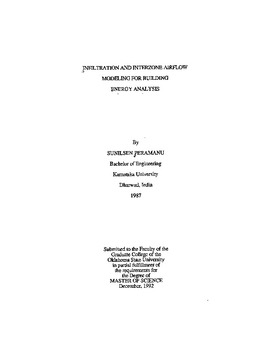| dc.contributor.author | Peramanu, Sunilsen | |
| dc.date.accessioned | 2014-11-03T16:09:02Z | |
| dc.date.available | 2014-11-03T16:09:02Z | |
| dc.date.issued | 1992-12-01 | |
| dc.identifier.uri | https://hdl.handle.net/11244/13535 | |
| dc.description.abstract | An infiltration and interzone airflow model was developed for use in building energy analysis. The model was implemented into the Building Loads Analysis and System Thermodynamics (BLAST) program. The theory, algorithms, solution method and computer program for modeling a variety of airflow elements such as cracks, doorways, ducts, and fans are described. Potential applications of the model are demonstrated with examples in the areas of attic ventilation, ventilative cooling of structures, and prediction of thermal comfort. A variety of tests indicated that the detailed analysis of building airflows is a practical possibility given adequate knowledge of building surface pressure coefficients and element flow parameters. The yearlong simulation of building airflow networks on an hourly basis for use in energy analysis is also feasible. Implementation of the model into the BLAST program has increased the usefulness of BLAST, particularly for cases where ventilation and/or interzone airflows have a significant effect on the thermal balance. | |
| dc.format | application/pdf | |
| dc.language | en_US | |
| dc.publisher | Oklahoma State University | |
| dc.rights | Copyright is held by the author who has granted the Oklahoma State University Library the non-exclusive right to share this material in its institutional repository. Contact Digital Library Services at lib-dls@okstate.edu or 405-744-9161 for the permission policy on the use, reproduction or distribution of this material. | |
| dc.title | Infiltration and interzone airflow modeling for building energy analysis | |
| dc.type | text | |
| osu.filename | Thesis-1992-P426i.pdf | |
| osu.accesstype | Open Access | |
| dc.description.department | Mechanical Engineering | |
| dc.type.genre | Thesis | |
